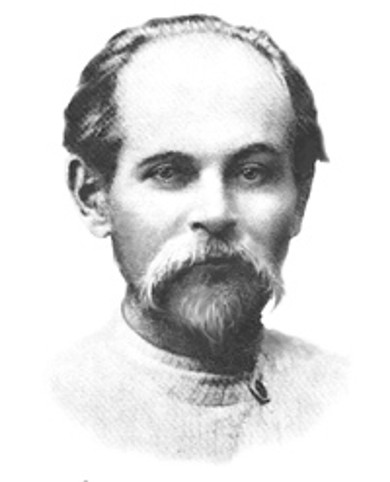We invite you to listen to a beautiful interpretation of
At Night on the Burial Mound ~ В ночі на могилі
Composer: Kyrylo Stetsenko
Poet: Boris Hrinchenko
Performers:
Russell Braun, baritone
Benjamin Butterfield, tenor
Pavlo Hunka, bass
Albert Krywolt, pianist
Translation: Uliana Pasicznyk
and Maxim Tarnawsky
I stand on a tall mound at night,
And look out around me;
The steppes shimmer as far as the eye can see,
With vague outlines of meadows in the far distance.
And the far edge of the steppes disappears
In waves of shiny clouds,
And the moon drowns them
In the silver of its rays.
And the heart years to fly there,
To the edge of the steppes,
There, where freedom still dances
Where human clamour is stilled.
Only the bones of the Kozaks are there,
And the land drenched in their blood.
It seems to me that there, perhaps,
My strength would grow.
There our forefathers defended freedom,
And there they buried it.
I believe that their sacred grave mounds
Would stir up my strength.
Silently I stand on the mound,
I stand, and look around.
The steppe still glistens with white moonbeams
The meadows on the horizon are still dim.
The steppes of Ukraine are dotted with ancient burial mounds. According to legend, many of these are graves of Kozaks who died fighting for Ukraine‘s freedom. Ukrainian sacred music is polyphonic in nature. Stetsenko uses three-part counterpoint to heighten the spiritual character of the song.
Нарциз Лукіанович
Вночі на могилі високій стою
І дивлюсь навкруги:
Степи тільки мріють широкі
Та з далека мріють темні луги.
І край того степу зникає
В туманових хвилях ясних,
А місяць сріблом обливає
Їх з неба в проміннях своїх.
І серце полинуть бажає
Туди, аж до краю степів,
Туди, де ще воля гуляє,
Де галас людський не гучнів.
Там тільки кістки ті козачі
Та кров’ю полита земля,
Здається мені, що неначе
Зміцніла б там сила моя.
Там волю діди боронили
І тaм поховали її,
Я вірю: святі їх могили
Розбуркали б сили мої.
І мовчки стою на могилі,
Стою і дивлюсь навкруги:
Біліють степи, як біліли,
Чорніють далекі луги....
В степах України розкидані давні могили. За легендами богатому з них могили козаків, які загинулиу у боротьбі за волю України. Цей триголосний романс є наче молитва за свободу. Українська церковна музика по природі є поліфонічна. Стеценко використовує триголосний контрапункт, щоб підвищити духовний настрій цього романсу.
KYRYLO STETSENKO
Kyrylo Stetsenko was born in central Ukraine. His father was a painter of icons and his maternal uncle was an Orthodox priest. At age 10, Kyrylo was taken by his uncle to Kyiv to study art. There, he enrolled at Saint Sophia's Church School and later at the Seminary. In school Kyrylo studied the masters of Ukrainian church music Dmytro Bortniansky, Maksym Berezovsky, Artem Vedel, and others. He also met Mykola Lysenko, the most important Ukrainian composer of the time, and participated in several ethnomusicological expeditions. Completing his studies in 1903, Stetsenko chose not to become a priest. Instead, he began working as a music teacher, music critic, church conductor and composer.
Stetsenko has to his credit 42 art songs, over 100 sacred and secular choral pieces, including two liturgies and a requiem, and music to a dozen stage works. Political events constantly affected the composer's life. When the Russian Revolution of 1905 fanned the flames of independence in Ukraine, Stetsenko published the Ukrainian national anthem and other patriotic songs. Although the authorities could not prove his complicity, he was nevertheless exiled from Kyiv in 1907. By 1909 he managed to return to the city but political and economic pressures forced him to leave one year later. In 1911, urged by his uncle, Stetsenko decided to become an Orthodox priest. Financial security, however, came at a price. The composer was required to serve in an obscure village in south-western Ukraine, far from the cultural life of Kyiv. There, in his self-imposed exile, Stetsenko weathered the political storm of World War I.
As soon as the Russian Revolution of 1917 began, Stetsenko immediately returned to Kyiv. When the Ukrainian National Republic was declared, Stetsenko was appointed head of the Music Section in the Ministry of Education. Two national choirs were created. One choir, led by composer Oleksander Koshyts, toured Europe and North America to promote Ukraine as an independent nation. The other, led by Stetsenko, toured at home to promote national unity. With the Bolshevik takeover of Ukraine in 1920, the Koshyts choir was stranded abroad. Meanwhile, Stetsenko's choir was disbanded by the Communists and the composer again abandoned Kyiv to work as a village priest south of the city. As political repressions were renewed against Ukrainians, famine and disease began to spread. Kyrylo Stetsenko died of typhus while tending to the sick during an outbreak of the disease in the spring of 1922.
CD Box set
The Ukrainian Art Song Project has been bringing Ukraine's musical treasures to light since 2004. With your support, we will continue to bring Ukraine's finest composers and their masterpieces to the world stage, where they belong.
Проєкт "Українськa Мистецькa Пісня" поширює найкращі зразки української музики з 2004 року. З Вашою підтримкою ми продовжимо презентувати найкращих українських композиторів та їх шедеври, які належать до світової музичної спадщини.
Your gift can also be made through CanadaHelps as a one-time or monthly donation.







